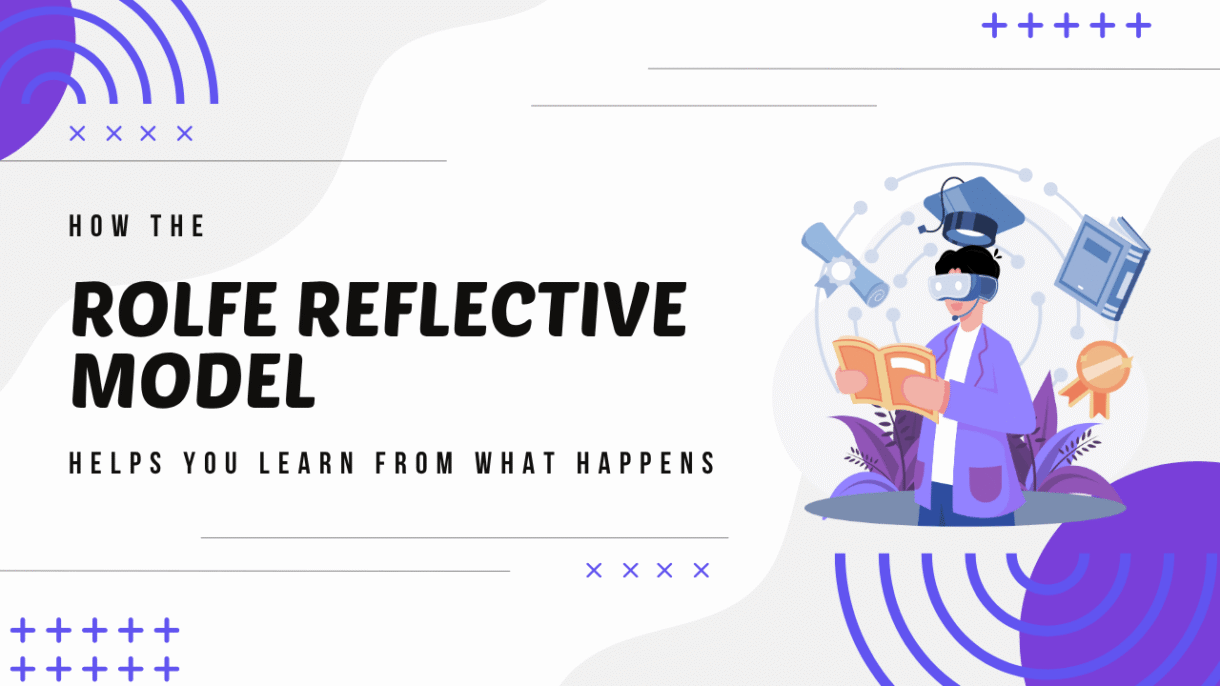
How the Rolfe Reflective Model Helps You Learn From What Happens

Are you like me, who keeps thinking about things again and again? That’s why I wanted to write about something that helped.
The Rolfe Reflective Model is something that helped me understand those moments, rather than just going in circles about them.
A study by Mann, Gordon, and MacLeod (2009) found that when people reflect on past events using a simple structure, it supports learning and personal growth.
You might not fully understand the moment right away. But later, when you start thinking about what happened and how you felt, that’s when the learning phase starts.
In this blog, we’ll go through how the Rolfe Reflective Model works and how you can use it in study, work, or everyday life.
First, What’s the Rolfe Reflective Model, and Why Is It Still Around?
I don’t know about you, but for me, sometimes something happens and later, even after it’s done, I keep thinking about it. That’s how I came across the Rolfe Reflective Model.
It may sound like a big name or an academic concept to you, I know, but trust me, it’s not that much. It’s only about observing deeply what is going wrong in a particular situation. Then learning from it, and being prepared to do the best in the future.
It came out in 2001. These three people made it:
- Gary Rolfe
- Dawn Freshwater
- Melanie Jasper
They were in teaching and healthcare. The kind of jobs where you’re always doing something but barely have time to stop and think about any of it. So they made something easy.
Three short questions:
- What happened
- Why is it important
- What should I do now
That’s pretty much what this model is. It’s not just something you read about. You can actually use it in real life, to think things through and grow a bit. People still use it, at work and in their own lives because it helps make sense of things you’ve already been thinking about.
So, How Does the Model Work?
To understand the function of this model, observe real-life scenarios, as again, this is not something to memorize. It only works by asking three simple questions: What? So What? Now What?.
To make it simpler, the what part is the problem arises in a particular situation. The next question is, so what? Which addresses the consequences or results of that. And the last part, now what is what should be done to do it better next time.
Let me give you an example from my second semester, and then everything will be clear to you on how you can apply this model in any situation.
Rolfe’s Reflective Model Example
Early in my second semester, we had to write a short research paper. I noticed the deadline was approaching, but convincing myself i would do it tomorrow. Days passed quickly, and i still didn’t even start.
I hadn’t yet chosen the topic for research, and the deadline was just around the corner. Then what I did was collect random topics from websites, just to submit something from my end. Even though i was sure it’s not perfect. After submission, the professor called me in front of all colleagues, and said you copied most of the part from the internet. I got a warning from the professor, and i knew it in advance it would happen. But at the time, I said nothing, just noticed what was wrong.
Now let’s put this scenario in Rolfe’s Reflective Model
What? – What happened?
I ignored the deadline, delaying the research paper until the last minute. I didn’t even choose a topic until the night before. All I did was copy parts from the internet. The professor noticed it; I said nothing, just sat there thinking. Yeah, it’s on me.
So What? – Why does it matter?
The professor called me out, and the situation worsened, as I knew in advance that what I had done was wrong.
Now What? – What will I do next?
What I will do next time is start earlier. Even if I don’t feel like it, I’ll at least get something real written. Not copy copy-paste job from the internet anymore.
Why Is the Rolfe Reflective Model Helpful?
When I heard about this model for the first time, I thought the same as people do: just three questions — how much can that help, right? But after I used it during the paper incident I shared earlier, it made more sense.
The questions do not ask for detailed answers that you have to study for. Believe me, it’s simple and self-explanatory questions you have to apply in any situation where you have done something wrong and want to improve in the future.
Just go through the questions:
- What happened?
- Why did it matter?
- What will I do now?
That’s it. Sounds basic, but it makes you stop and look at what went wrong. Or even what went right sometimes.
Here’s why I found it useful:
- It’s really easy to use. You don’t have to learn anything new to start.
- You can use it for anything — missed deadlines, bad group work, even just small mistakes you made.
- It helps you not repeat the same thing again, which is the whole point of reflecting anyway.
Before, I’d just move on from something and say, “whatever.” But this made me pause for a minute and actually take something from it.
You don’t need to be in a hospital or office job to use it. If you’re a student like me, this is something you can use anytime when things don’t go the way you planned.
Who Can Use the Rolfe Model Reflection?
You might have heard of this model, specifically related to nursing or hospitals, as in most content we find definitions like this. That’s not incorrect either, but its not limited to any special industry, age group, or any other special criteria is there.
The Rolfe Model reflection can be used by anyone. You don’t need to be a professional or have a big title. Even if you’re just trying to get better at handling daily life, this can help.
However, below are some of the areas where it is most effective to apply.
Students
You can use what so what now what model in student life, as I did in my example. Being a student, wherever you think you’re lagging in something, like late submission, or group task, etc, you can adopt this model to think what went wrong and what you can do next time.
After all, if you’re still worried about things like late submission and group tasks, you can get professional research and assignment help from platforms available online.
Teachers
Teachers can also reflect on their actions, their teaching style, etc., if a teacher delivers a lecture and notices the student’s reaction, as the student did not get what the teacher wanted. It helps improve teaching slowly, one class at a time.
Healthcare workers
This is where it started. Nurses and doctors use it after stressful or difficult situations to think about their decisions and improve future care.
Managers or team leaders
The rolfe model reflection is useful in project management. Being a manager or a team lead, if you think if you think there is conflict in a strategy or team, you can rely on these three questions: what , so what , now what and reach a tangible solution easily.
If you are not in any of the above-mentioned categories. The Rolfe Model is still useful. Maybe you had a bad conversation with a friend. Or you forgot something important. You can still ask yourself — what happened, so what, and now what.
Because at the end of the day, it’s not about the job or the subject. It’s just about learning from stuff that didn’t go the way you wanted.
When Should You Use the Rolfe Model Reflection?
Sometimes people wait for something big to happen before they reflect. Like a major failure or a serious problem. But honestly, Rolfe Model reflection doesn’t need to be saved for big events only.
You can use it in small situations too — moments that don’t feel like a big deal at first but still leave you thinking later.
Here are some examples of when you can use it:
- After a mistake, big or small. Could be missing a deadline or saying something you regret.
- When something goes well — yes, even success. You can still reflect to understand what worked and why.
- When you feel stuck — like when you’re doing something over and over, but not improving.
- After getting feedback — from a teacher, a manager, or even a friend. It helps you process it.
- Before making a change — reflection can guide your next step when you’re unsure what to do.
You don’t need to sit down and write an essay every time. Even thinking quietly through the three questions can help:
What happened?
So what?
Now what?
That’s enough to get you moving in a better direction. And the more you do it, the more it becomes a habit — not something you force, but something that just happens naturally in your head.
Let’s Compare the Rolfe Model Reflection with Other Reflection Models
There are different models made for reflection, and while they all serve the same purpose, they don’t work the same way. Some go deeper, some keep it basic.
Here’s a short look at three popular ones — Rolfe, Gibbs, and Driscoll — so you can see how they differ and when each one fits best.
A Quick Look at the Three Models
Rolfe Model
This one only has three questions. What? So what? Now what? It doesn’t ask for long answers, and you can even think through it without writing anything. I used it after messing up a paper, and it actually helped.
Gibbs Model
This one has six steps and asks a lot more — like how you felt, what you learned, what went wrong, what you’d change. It’s useful if you’re writing a full assignment or reflective report, but honestly, it takes time and feels heavy sometimes.
Driscoll Model
Driscoll’s model of reflection also uses What, So What, Now What — same as Rolfe — but it comes with guiding questions under each part. It’s used more in healthcare or clinical areas, and it’s good if you need structure but don’t want something as long as Gibbs.
Simple Comparison Table
|
Model |
Steps Used |
What It Focuses On |
Best Used For |
My Thoughts |
|
Rolfe |
What? So What? Now What? |
Quick thinking and real-world action |
Small reflections, daily situations |
Easy to use. Feels natural |
|
Gibbs |
Six full steps |
Emotions, breakdown, learning plan |
Essays, long reports, deeper writing |
Takes effort. Better for assignments |
|
Driscoll |
Same three steps as Rolfe |
Reflection with guided questions |
Clinical and healthcare reflection |
Simple, but more detailed than Rolfe |
Not only in professional setups, but I’m sure the Rolfe Model of reflection fits for everyday tasks and actions. I’m not saying the others are bad, but Rolfe works when you don’t have time to overthink, and still want to learn something.
Does The Rolfes’ Reflective Model Need Referencing?
You might be thinking why this simple model, which is based on three simple questions would need referencing. This is what i was also curious about. I didn’t think something this simple would need referencing. It’s just three questions after all. But then I found out it actually came from a proper academic book back in 2001. The founders are Rolfe, Freshwater, and Jasper.
So yeah, it’s not just general advice. It’s someone’s published work, and we have to credit them. That’s why, if you use it in assignments or anything academic, you’re supposed to reference it.
How Do APA or Harvard Apply to a Model Like This?
It’s not like quoting a sentence. You’re just saying where the model came from. You treat it like any other concept or method. The names of the authors, the year it was published, and the book title. That’s what referencing styles like APA or Harvard are for. So even though it’s just a few questions, it still counts as proper academic content.
In short, the model might be easy to use, but it’s still official work by someone else. And in uni writing, that means it should be credited — even if it’s just three lines.
Conclusion
To put it in simple words, the Rolfe Reflective Model helps you all in decision-making. This model has increased my decision-making skills by 2x. And the good news is that it is not specific to any specialized field; anyone can apply it at any stage of their professional and personal life.
The model is not like memorizing and applying a complex mathematical formula. It is simply asking three questions when a situation arises. What happened? So what? And now what? By doing that, you can easily figure out what went wrong, what the result of if or the consequences, and how you can do it better next time. Believe me, it saved me from going around in circles many times about taking action, and so will it for you.

Nemo Me Impune Lacessit’: The Drive for Justice
Home / Nemo Me Impune Lacessit’: The Drive for Justice in “The Cask of…

Peacocks and Pomegranates: Decoding Hera’s Iconic Symbols in
Home / Peacocks and Pomegranates: Decoding Hera’s Iconic Symbols in Greek Mythology Peacocks and…

Unraveling the Layers: An Analysis of ‘Mom’s Spaghetti’
Home / Unraveling the Layers: An Analysis of ‘Mom’s Spaghetti’ Lyrics Unraveling the Layers:…

Understanding the Depth in “Colors of the Wind”
Home / Understanding the Depth in Colors of the Wind Understanding the Depth in…

Film Analysis: Delving into the Depths of the
Home / Film Analysis: Delving into the Depths of the Entire ‘Bee Movie’ Script…

Understanding the Dawes Act: Definition and Impact on
Home / Understanding the Dawes Act: Definition and Impact on Native American Lands Understanding…

Catherine Roerva: A Complex Figure in the Narrative
Home / Catherine Roerva: A Complex Figure in the Narrative of Child Abuse Catherine…

The Story Behind the Face on the $50
Home / The Story Behind the Face on the $50 Bill The Story Behind…
Get Your Assignment Now!
Why
Choose Our Services
00+
Projects
00+
Students
00+
Orders


0 Comments